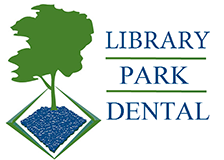How to Brush Your Teeth

Did you know that toothbrushes were not commonly used in the United States until after World War II? Toothbrushes were part of the basic hygiene kit and as the soldiers came home they brought the habit of brushing teeth with them.
- You have to have the right toothbrush. You do get what you pay for with toothbrushes. It is best to use a brush with soft bristles with rounded ends. A rounded head allows the brush to get into the back of the mouth and between the teeth.
- You need to make sure to change your toothbrush or toothbrush head (on electric toothbrushes) approximately every three months. Pay attention to how the bristles look. If they are frayed or splayed out then you should replace it, or bacteria can get in the bristles and cause an infection.
- Use the right toothpaste. Ask your dentist or hygienist at Library Park Dental what toothpaste is right for you. A fluoridated toothpaste will help to strengthen enamel while a desensitizing toothpaste will help reduce pain. Tooth whitening can be accomplished with special whitening toothpaste. There are other types of toothpaste for other dental issues and your dental team can help you find one to meet your needs.
- Brush your teeth for a minimum of two minutes. You need to angle your brush at a 45-degree angle from the gum line and use vertical or circular motions. Be sure to brush the outer surfaces as well as the inner surfaces. Brush the chewing surfaces and behind the molars. You do not need to brush vigorously; brushing too hard can actually cause problems. Gently brush each quadrant of the mouth for approximately 30 seconds. Finally, brush your tongue gently. This will remove bacteria and keeps bad breath away.
- Don’t forget to floss. Use a sawing motion with the floss instead of snapping the floss down between the teeth. This will keep the gum tissue from getting inflamed. The American Dental Association states that it doesn’t matter whether you floss before or after brushing your teeth, except that if you floss first, the fluoride in your toothpaste can get to more areas of the tooth.
- Follow brushing by rinsing your toothbrush. This removes the bacteria from your mouth and prevents you from re-introducing old bacteria into your mouth the next time you brush.
- Remember to brush at least twice a day for two minutes for optimal dental health.
If you have any other questions about brushing techniques, be sure to ask your dentist or a member of your Library Park Dental team.
